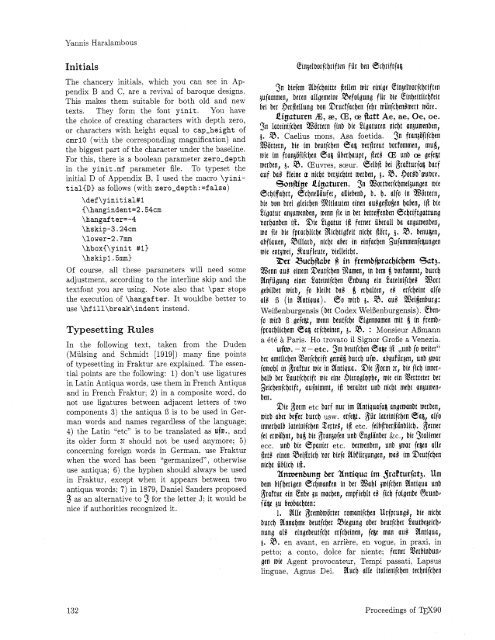Typesetting Old German: Fraktur, Schwabacher, Gotisch and ... - TUG
Typesetting Old German: Fraktur, Schwabacher, Gotisch and ... - TUG
Typesetting Old German: Fraktur, Schwabacher, Gotisch and ... - TUG
You also want an ePaper? Increase the reach of your titles
YUMPU automatically turns print PDFs into web optimized ePapers that Google loves.
Yannis Haralambous<br />
Initials eindelborfc$riften fur ben &$riftfat,<br />
The chancery initials, which you can see in Ap-<br />
pendix B <strong>and</strong> C, are a revival of baroque designs.<br />
This makes them suitable for both old <strong>and</strong> new<br />
texts. They form the font yinit. You have<br />
the choice of creating characters with depth zero,<br />
or characters with height equal to cap-height of<br />
cmrl0 (with the corresponding magnification) <strong>and</strong><br />
the biggest part of the character under the baseline.<br />
For this, there is a boolean parameter zero-depth<br />
in the yinit .mf parameter file. To typeset the<br />
initial D of Appendix B, I used the macro \yini-<br />
t ialCD) as follows (with zero-depth : =false)<br />
\def\yinitial#l<br />
C\hangindent=2.54cm<br />
\hangaf t er=-4<br />
\hskip-3.24cm<br />
\lower-2.7mm<br />
\hbox(\yinit #I)<br />
\hskipl.5mrn)<br />
Of course, all these parameters will need some<br />
adjustment, according to the interline skip <strong>and</strong> the<br />
textfont you are using. Note also that \par stops<br />
the execution of \hangafter. It wouldbe better to<br />
use \hf ill\break\indent instead.<br />
<strong>Typesetting</strong> Rules<br />
In the following text, taken from the Duden<br />
(Mulsing <strong>and</strong> Schmidt [1919]) many fine points<br />
of typesetting in <strong>Fraktur</strong> are explained. The essen-<br />
tial points are the following: 1) don't use ligatures<br />
in Latin Antiqua words, use them in French Antiqua<br />
<strong>and</strong> in French <strong>Fraktur</strong>: 2) in a composite word, do<br />
not use ligatures between adjacent letters of two<br />
components 3) the antiqua fi is to be used in Ger-<br />
man words <strong>and</strong> names regardless of the language;<br />
4) the Latin "etc" is to be translated as ufm.. <strong>and</strong><br />
its older form 2c should not be used anymore; 5)<br />
concerning foreign words in <strong>German</strong>. use Raktur<br />
when the word has been "germanized", otherwise<br />
use antiqua: 6) the hyphen should always be used<br />
in <strong>Fraktur</strong>, except when it appears between two<br />
antiqua words; 7) in 1879, Daniel S<strong>and</strong>ers proposed<br />
3 as an alternative to fS for the letter J; it would be<br />
nice if authorities recognized it.<br />
(Sn biefem Ubfcbnitte tellen mir einige Eingelborfcljriften<br />
aufammen, beren allgemeine Qefolgung fiir bie Einbeitlicbfeit<br />
bei ber $)erfteIlung bon 9rucffacben feljr miinfct)enBmert mare.<br />
Qigaturen IE, ae, (E, oe ftatt Ae, ae, Oe, oe.<br />
fSn Iateinifcben %ortern finb bie eigaturen nicbt angumenben,<br />
a. 8. Caelius mons, Asa foetida. fSn franadfifcben<br />
%ortern, bie im beutfcben @a$ bertreut borfommen, mu%,<br />
mie im frangofifcben Oat, iiberbaupt, fie10 (E unb ae gefe$t<br />
merben, i. %. auvres, sceur. Oelbff bei jJrafturfa$ barf<br />
auf bad fleine la nicbt bergicbtet merben, 8, %. $)orBb'laubre.<br />
6onwge Qigaturen. fSn %ortberfcbme[dungen mie<br />
@ct)ifa$rt, @cljnellaufer, alliebenb, b. 6. alfo in %ortern,<br />
bie bon brei gleicben %itlauten einen auBgeffo$en baben, iff bie<br />
eigatur <strong>and</strong>umenben, menn fie in ber betrefenben Ocbriftgattung<br />
borbanben it. Die eigatur iff ferner iiberall ba angumenben,<br />
mo fie bie fprac$lic$e 9Iicbtigfeit nicbt ffort, 4. %. benulen,<br />
abflauen, Billarb, nicljt aber in einfacben '&fammenfet,ungen<br />
mie entamei, Raufleute, bielleicbt.<br />
Ber 3ucIjftabe tj in frembfprac~icIjem 6at3.<br />
%enn au8 einem Deutfcben %amen, in bem $ borfommt, burcb<br />
Bnfiigung einer &ateinifcben enbung ein 2ateinifcbeB sort<br />
gebilbet mirb, fo bIeibt bag $ erbalten, e0 erfc$t.int aIfo<br />
aiB J3 (in Bntiqua). 60 mirb a. @. aul %titenburg:<br />
Weifienburgensis (ber Codex Weifienburgensis) . Eben,<br />
fo mirb J3 gefetjt, menn beutfcbe Eigennamen mil $ in fremb.<br />
fpracblicbem @a$ erfcbeinen, a. %. : Monsieur Afimann<br />
a 6t6 B Paris. Ho trovato il Signor Grofie a Venezia.<br />
ufw. - 2c - etc. (Sm beutfcben @ate iff ,,unb fo meiter"<br />
ber amtlicben %orfc$rift #ma$ burcb ufm. abiufiiraen, unb gmar<br />
forno!$ in graftur mie in Bntiqua. Die Sorm tc, bit ficb inner.<br />
balb ber eautfcljrift mie eine $)ieroglt)pbe, mie ein gertreter ber<br />
3eicljenfc$rift, aufnimmt, iff beraltet unb nicbt mebr angumen#<br />
ben.<br />
Die germ etc barf nur im antiquafa$ angemanbt merben,<br />
mirb aber befer burcl) USW. erfe$t. Biir Iateinifcben @a$, alfo<br />
innerbalb loteinifcben ZeyteB, iff etc. felbffbertanblicb. gerner<br />
fei ermabnt, ba$ bie Sraniofen unb Englanber &c., bie 3taliener<br />
ecc. unb bie Opanier etc. bermenben, unb imar fet,en alle<br />
Pet0 einen Beiffricb bor biefe Ubfiirgungen, ma0 im Deutfcben<br />
nicbt iiblicb ifi.<br />
Unwenbung ber Untiqua im fratturfatj. Um<br />
bem bifberigen Ocbmanfen in ber %a$[ imifcben Untiqua unb<br />
graftur ein Enbe gu macben, empfieblt eB ficb foigenbe @runb+<br />
fate au beobacbten:<br />
1. UIle @rembmorter romanifcben UrfprungB, bit nlcbt<br />
burcl) Unnabme beutfcber aiegung ober beutfcber $autbegeic$p<br />
nung a10 eingebeutfcbt erfcbeinen, fete man auB Untiqua,<br />
i. %. en avant, en arrikre, en vogue, in praxi, in<br />
petto; a conto, dolce far niente; ferner %binbun.<br />
gen mie Agent provocateur, Tempi passati, Lapsus<br />
linguae. Agnus Dei. %ucb alle italienifcljen tecbnifcljen<br />
Proceedings of m9O

















